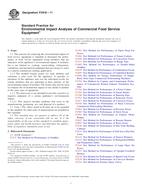1.1 This test method covers the procedure for distillation of heavy hydrocarbon mixtures having initial boiling points greater than 150°C (300°F), such as heavy crude oils, petroleum distillates, residues, and synthetic mixtures. It employs a potstill with a low pressure drop entrainment separator operated under total takeoff conditions. Distillation conditions and equipment performance criteria are specified and typical apparatus is illustrated.
1.2 This test method details the procedures for the production of distillate fractions of standardized quality in the gas oil and lubricating oil range as well as the production of standard residue. In addition, it provides for the determination of standard distillation curves to the highest atmospheric equivalent temperature possible by conventional distillation.
1.3 The maximum achievable atmospheric equivalent temperature (AET) is dependent upon the heat tolerance of the charge. For most samples, a temperature up to 565°C (1050°F) can be attained. This maximum will be significantly lower for heat sensitive samples (for example, heavy resudes and might be somewhat higher for nonheat sensitive samples.
1.4 The recommended distillation method for crude oils up to cutpoint 400°C (752°F) AET is Test Method D 2892. This test method can be used for heavy crude oils with initial boiling points greater than 150°C (302°F). However, distillation curves and fraction qualities obtained by these methods are not comparable.
1.5 This test method contains the following annexes:
1.5.1 Annex A1 – Test Method for Determination of Temperature Response Time,
1.5.2 Annex A2 – Practice for Calibration of Sensors,
1.5.3 Annex A3 – Test Method for Dehydration of a Wet Sample of Oil,
1.5.4 Annex A4Practice for Conversion of Observed Vapor Temperature to Atmospheric Equivalent Temperature (AET), and
1.5.5 Annex A5 – Test Method for Determination of Wettage.
1.6 The values stated in SI units are to be regarded as the standard. The inch-pound units given in parentheses are provided for information purposes only.
1.7 This standard does not purport to address all of the safety concerns, if any, associated with its use. It is the responsibility of the user of this standard to establish appropriate safety and health practices and determine the applicability of regulatory limitations prior to use. For specific warnings, see 6.5.4.2, 6.5.6.3, 6.9.3, 9.5, 9.7, and A2.3.1.1.
Product Details
- Published:
- 06/10/2003
- Number of Pages:
- 18
- File Size:
- 1 file , 380 KB
- Redline File Size:
- 2 files , 730 KB


